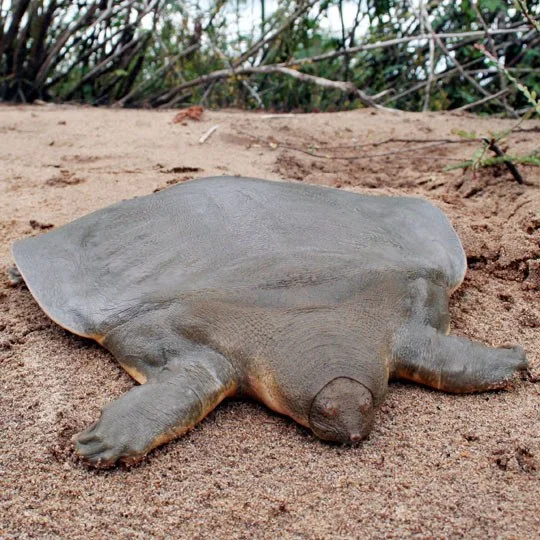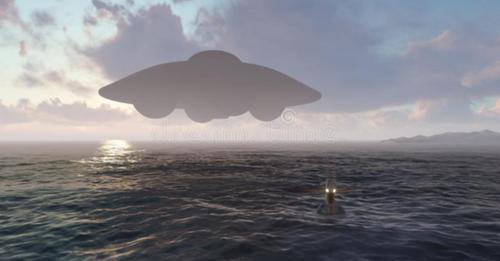The Pelochelys cantorii, widely recognized as the Cantor’s giant softshell turtle, is an extraordinary and enigmatic reptile native to the freshwater ecosystems of Southeast Asia, including countries like India, Bangladesh, Myanmar, Thailand, Malaysia, and Indonesia. Unlike the stereotypical image of a turtle encased in a hard, bony shell, this species defies convention with its unique anatomy, featuring a layer of thick, rubbery skin that envelops its wide-spanning, fused ribs, offering a flexible yet effective shield for its internal organs. Capable of reaching an impressive length of up to 6 feet (1.8 meters) and weighing as much as 200 kilograms (440 pounds), it stands as one of the largest freshwater turtles globally. As of 10:54 AM +07 on Saturday, July 19, 2025, this remarkable creature continues to fascinate researchers and conservationists while facing significant challenges to its survival.

A Turtle Unlike Any Other
The absence of a traditional outer shell sets the Cantor’s giant softshell turtle apart from its relatives, such as the common box turtle or sea turtle. Instead, its protective covering is a leathery, pliable skin that allows for greater maneuverability in its aquatic habitat. This adaptation is complemented by its flattened, disc-like body, which, combined with a broad, flattened head and a snorkel-like snout, gives it a striking resemblance to a frog—an appearance further enhanced by its webbed feet and long, flexible neck. The turtle’s coloration, typically an olive or grayish-brown with darker mottling, provides excellent camouflage against the muddy riverbeds and sandy bottoms where it resides. Its size and unusual form make it a standout species, with historical accounts and modern observations noting its imposing presence in the wild.
Habitat and Behavior: A Master of Ambush
The Pelochelys cantorii thrives in a variety of freshwater environments, including slow-moving rivers, lakes, swamps, and coastal estuaries across its range. It prefers habitats with soft, sandy or muddy substrates, where it can employ its distinctive burrowing behavior. By submerging itself beneath the sand or silt, the turtle leaves only its snout exposed, using it as a natural snorkel to breathe while lying in wait for prey. This ambush strategy is highly effective, allowing it to strike with lightning speed at fish, crustaceans, mollusks, and occasionally aquatic insects or vegetation. Its powerful jaws, equipped with a sharp, beak-like edge, enable it to crush the shells of its prey with ease. The turtle’s webbed feet and streamlined body facilitate swift movements through water, while its ability to remain motionless for hours demonstrates remarkable patience and adaptation to its environment.
Life Cycle and Reproduction
Little is known about the reproductive habits of the Cantor’s giant softshell turtle due to its elusive nature and declining population. However, it is believed to lay eggs in sandy riverbanks or coastal dunes during the warmer months, with females potentially producing clutches of 20 to 40 eggs. The eggs, like those of other softshell turtles, are soft-shelled and vulnerable to predators and environmental changes. Hatchlings emerge after an incubation period of about 60 to 70 days, measuring just a few inches long and facing immediate threats from birds, fish, and human activity. The slow maturation rate of this species—often taking 15 to 20 years to reach adulthood—further complicates its ability to recover from population declines.
Threats to Survival: A Species Under Pressure
Despite its impressive adaptations, the Pelochelys cantorii faces a precarious future. One of the primary threats is hunting, as its flesh is considered a delicacy in some regions, and its eggs are harvested for food. This demand, driven by local markets and traditional practices, has significantly reduced its numbers. Additionally, the loss of its natural habitats poses a severe risk. Coastal development for tourism and industry, river pollution from agricultural runoff and industrial waste, and deforestation along riverbanks have fragmented and degraded its living spaces. The construction of dams and irrigation projects further disrupts its migratory patterns and breeding grounds. Classified as critically endangered by the International Union for Conservation of Nature (IUCN), urgent conservation measures are essential to prevent its extinction.
Conservation Efforts and Challenges
Conservation initiatives are actively addressing these threats, with organizations working to protect key habitats through the establishment of reserves and sanctuaries. Anti-poaching patrols and community education programs aim to reduce hunting pressure by promoting sustainable alternatives and raising awareness about the turtle’s ecological role. Efforts to restore riverine and coastal ecosystems, including reforestation and water quality improvement, are also underway. However, challenges persist, including limited funding, the turtle’s secretive lifestyle making population monitoring difficult, and the slow reproductive cycle hindering rapid recovery. As of 10:54 AM +07 on July 19, 2025, these efforts remain a critical race against time.
Visual Insight and Modern Observation
The image credited to Dementia on Flickr, licensed under CC BY-SA 2.0, likely captures the turtle’s distinctive features—its leathery skin, submerged posture, and frog-like snout—offering a rare glimpse into its natural behavior. Modern observations, often aided by underwater cameras and drone surveys, have helped document its presence in remote areas. Visitors to regions like the Sundarbans or the Ayeyarwady River may occasionally spot this elusive creature, though sightings are rare due to its camouflaged lifestyle. Early morning visits, like now at 10:54 AM +07, are optimal for observing wildlife in these habitats, though direct interaction is discouraged to protect the species.
Practical Tips for Engagement
For those interested in learning more, virtual tours and documentaries provide safe access to its world. In person, respectful observation from a distance is key—bring binoculars, wear lightweight clothing, and avoid disturbing nesting sites. Conservation groups occasionally offer guided eco-tours, emphasizing education over exploitation. The turtle’s plight underscores the broader need to preserve freshwater ecosystems, a mission gaining traction globally.
Conclusion
The Cantor’s giant softshell turtle, with its shell-less design and remarkable adaptations, is a living testament to nature’s diversity. Growing to 6 feet and thriving in Asia’s rivers, it faces extinction due to hunting and habitat loss. As we reflect on its story at 10:54 AM +07 on July 19, 2025, its conservation becomes a pressing call to action, preserving a unique piece of our natural heritage.





